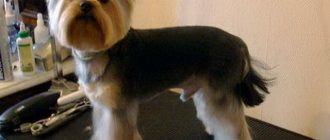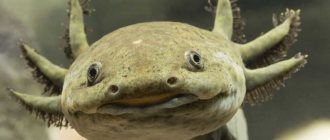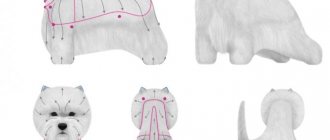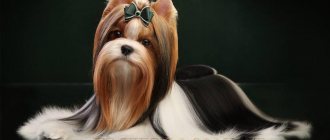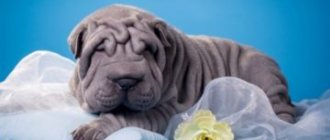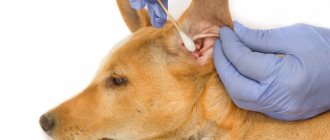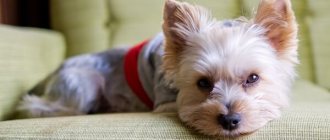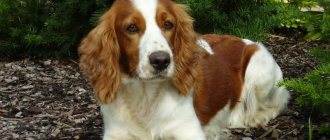The Yorkshire Terrier is a miniature, charming, and inquisitive dog. The beauty of the breed lies in its rich coat and cute appearance.
The Yorkie's skin is hypoallergenic, so even people sensitive to fur can keep it at home. The dog does not shed, has no specific odor, but is picky about grooming.
Your Yorkie needs to be groomed regularly. Therefore, if you want to have just such a mini creature in your apartment, it is important to familiarize yourself with the rules for caring for and maintaining these cute dogs.
Briefly about Yorkshire Terriers
Yorkshire terriers are unique owners of hair that looks more like fine human hair. Due to the fact that this breed does not have an undercoat, the Yorkie does not shed, which makes it very convenient for keeping in an apartment or house.
However, precisely because of this feature, they need special coat care, which is very difficult and time-consuming.
Due to the lack of undercoat, Yorkies are very sensitive to cold and drafts. You also need to take into account other breed characteristics of these dogs, which complicate their care and make their maintenance more difficult.
Walking and exercise
Miniature breeds do not need long walks. It is enough for them to go outside twice a day for 15–20 minutes. Of course, if you want to walk with your pet longer, this will only benefit him. But in the cold season you can’t stay outside for too long, the dog can catch a cold and get sick.
Proper care of a Yorkshire Terrier is not possible without taking care of its warmth. The breed is naturally devoid of undercoat; in the cold season it is necessary to wear overalls, and in the rain - a raincoat.
The terrier does not need physical activity, it has a fast metabolism, and the breed is not prone to obesity. But this does not mean that you can just walk with your dog on a leash. Take your pet to an area fenced off from the road, play ball with him, and let the baby frolic to his heart's content.
How to care for a puppy?
Most Yorkshire terriers arrive at a new home at the age of three months - this is when, according to the requirements of kennel clubs, puppies are allowed to be sold.
By this age, a Yorkie puppy can already be trained in some commands , as well as in a diaper or tray. Many of them are also familiar with bathing and brushing, which makes caring for a new family member much easier.
In the first days, the puppy may whine at night, you need to be prepared for this. If the baby begins to squeak and scratch at the door, you should calm him down and take him to a pre-prepared place.
In the first days, it is very important not to disrupt the puppy’s usual feeding diet - no experiments are allowed in the first two weeks after purchasing it. You need to feed him what he is used to eating from the breeder and only then switch him to a diet that is more convenient for the new owner.
Already at this time, you need to start raising the Yorkshire and teaching him simple commands and accustoming him to the tray.
The ears, eyes and teeth of a puppy, like those of adult dogs, should be examined every day, and cleaned only when necessary. The same goes for trimming nails.
IMPORTANT!
Bathing your baby should be postponed for at least a week after purchasing a pet, since separation from his mother and moving to a new home was already very stressful for him.
A puppy's coat does not yet have the same structure as that of adult dogs, but it also needs regular brushing. In addition, these manipulations will later help the Yorkie quickly get used to more complex care of its coat, including haircuts or curling the hair into curlers.
For the first time, a Yorkie can be cut when its coat has grown sufficiently, as a rule, this happens no earlier than six months. Show Yorkies are not cut at all, but from about the same age their hair begins to be curled into curlers.
Nuances of care
Features of keeping a Yorkshire Terrier depend on:
- age;
- condition;
- and even gender.
The complex includes hygiene, nutrition, vaccinations, haircuts, etc. If the procedures are carried out correctly, this will not cause much trouble, and the dog will accept all manipulations normally.
For newborn puppies
In the first days of life, his mother takes care of the Yorkie puppy: she feeds and licks it, turns it over and makes sure that the children do not crawl out of the bed. With mother's milk, small Yorkshire terriers receive barrier immunity and everything necessary for the growth of the body.
Basic rules for caring for an adult dog
Caring for an adult Yorkie is not so difficult - with the exception of labor-intensive care for their coat, these dogs need all the same hygienic manipulations as dogs of other breeds.
Just like small puppies, they need to clean their eyes and ears, trim their nails, and from time to time remove plaque from their teeth.
Hair care for an adult Yorkie varies depending on whether it is a show dog or not. Haircuts are prohibited for dogs participating in exhibitions. But it’s better to cut your pet’s hair short to make caring for its fur easier.
In order for an adult Yorkie to calmly tolerate hygiene procedures and other manipulations, he needs to be accustomed to them from an early age.
Expert opinion
Kozhevin Semyon Kirillovich
Expert dog handler.
If the Yorkie is not being exhibited or has already finished his career, it is recommended to cut it - this will be more comfortable for both the dog and the owner. You can’t wash your Yorkie too often, but you definitely need to brush it every day. Dogs of this breed require periodic dental care; in some cases, they may even need to be cleaned in a clinic. And the Yorkie is a breed that cannot do without clothes, as it gets cold easily and can catch a cold. These dogs are unpretentious in nutrition, the main thing is not to spoil them from childhood, then they will eat everything that the owner offers them.
Health and treatment
Yorkshire Terriers are prone to colds. To prevent illness, you should dress your Yorkie warmly when walking in cold weather and avoid drafts at home.
Breeders have identified the main diseases of dogs of this breed:
- Skin diseases. They often occur due to improper care, insufficient hygiene, frequent or infrequent bathing.
- Eye diseases.
- Joint diseases, most often congenital.
- Diseases of the kidneys and urinary tract.
- Hernia.
- Allergy.
- Respiratory spasm.
For any manifestation of disease, you should contact a veterinarian. Under no circumstances should you resort to self-medication - this can harm your pet.
You need to care for your Yorkshire Terrier from the first days of his life until the last hour. For any animal lover, a dog is part of the family. Hygienic procedures will give the owner only joy, because it’s so nice to take care of someone! And following the rules of nutrition, vaccination and proper care can prolong the life of a Yorkie.
What do you need to prepare before buying a pet?
Buying a dog is a responsible matter, and you need to prepare for this event in almost the same way as for the birth of a child.
Here is a list of what you will need to buy and prepare before bringing your Yorkie puppy home:
- bed;
- various toys - rubber, made of veins, in the form of braided braids, etc. You can also purchase a fairly large soft toy, which at first will become a “foster mother” for the puppy, next to which he can bask, and later play with it, carrying it in his teeth;
- ceramic, enamel or metal bowls for food and water. It is not recommended to buy plastic dishes for puppies, as they often cause allergies;
- bath towels;
- a special comb or even several different combs - it is better to check with the breeder which ones you will need for the first time;
- special toothpaste and brush for puppies;
- shampoo suitable for puppies of long-haired breeds;
- food that the puppy is accustomed to in the breeder’s house;
- vitamins for puppies.
NOTE!
Clothes, leashes and collars, as well as a carrier, should be purchased when the puppy has already settled in the house, since these items need to be selected individually.
Basic content rules
A good owner will have a healthy, well-fed and clean Yorkshire Terrier, with a beautiful, well-groomed coat. The Yorkie should have his own bed or other individual place (for small puppies, you can put a crate or carrier so that they can rest there and sneak toys inside). You should not allow your pet to climb into places where people sleep.
The toilet problem in puppies is solved with the help of absorbent diapers, which are placed in the place that he chooses. There are also special trays for small dogs.
But the owner must be prepared for “unauthorized” puddles and piles: emotional Yorkies may wet themselves with joy when the owner returns or poop from fear. By the age of one year, the Yorkshire Terrier usually fulfills all its needs while walking. Read about how to properly toilet train a Yorkie in this article.
The equipment must be suitable for the dog in size and weight, as well as food and drinking utensils. Dimensions gradually increase as the Yorkshire Terrier matures. Household items must be clean.
Personal place
The bed should not be located on the aisle or in a draft. It is unacceptable to place it in the bathroom or toilet, and the kitchen is not the best place for a dog, even a small one.
It is best to place the Yorkie's place in one of the rooms, preferably where the whole family tends to gather, since these dogs are very sociable and simply adore the company of people.
In addition to a regular bed, you can also purchase a dog house where your pet can go when he wants to be alone.
How and what to feed?
You can feed dogs only high-quality and fresh food.
If this is a purchased food, then only the best of all possible and no lower than premium, and if it is a natural food, the basis of the diet should be protein products. Moreover, it is better to give puppies more fermented milk products, and adult animals - meat.
Natural feeding should also include cereals, fresh and boiled vegetables, except potatoes. It is useful to give your pet fruits and greens from time to time if he is not allergic to them. At the same time, it is not recommended to treat your Yorkie with exotic fruits and vegetables - they are too allergenic for dogs who are not accustomed to them.
IMPORTANT!
The finished food should be appropriate for the dog’s age, size, activity and health status. Ideally, this should be a food designed specifically for Yorkshire Terriers.
The right diet
For up to a month, babies feed on mother's milk, but the breeder can introduce complementary foods in the form of cow's or goat's milk, liquid milk porridge. Once the Yorkie reaches 4 weeks, additional foods must be added to his diet, such as beef or chicken (finely chopped meat diluted with warm water), boiled eggs, cottage cheese, low-fat kefir, water-based porridge, boiled vegetables, pumpkin. There can be no talk of any ready-made food until 2 months; up to 8 weeks, only a natural diet.
Attention! Products for puppies, like children, should be added one at a time and see how the puppy reacts to them. Only if the body has accepted the new food well, then you can add another one every other day.
From the age of two months, a Yorkshire Terrier puppy can be switched to dry food, but you should still stick to the idea of feeding regular food. It’s worth asking the breeder what the mother of the puppies eats, what the puppies have already tried to eat, and based on the information received, create a menu for your “tail.”
You can follow the breeder's recommendations, but the owner ultimately decides what to feed the puppy. Here are some rules that will ensure proper care for your Yorkie puppy.
Ready-made food or natural food:
- If you feed ready-made dog food (dry or canned), you need to choose it according to your veterinarian's recommendations. Budget varieties are not allowed, only premium ones. The advantage of the food is that it is balanced, it contains all the substances and microelements necessary for a dog’s health. There is no need to prepare anything special for your pet.
- All dogs love natural food, but the diet must be properly formulated. For Yorkshire Terriers, the food should consist of 75% animal products and 25% plant products. It is not allowed to feed the dog the same dishes that people eat; you will have to prepare it separately for the puppy.
When choosing ready-made food, it is recommended to buy special food for Yorkshire terriers.
Mandatory products for natural nutrition of Yorkshire terriers:
- lean meats (both boiled and raw);
- dairy products;
- chicken eggs (once a week);
- offal;
- fruits and vegetables;
- cereals;
- boiled fish, boned;
- vegetable oil;
- rye crackers.
The following are excluded from the natural diet:
- pork;
- peas and any legumes;
- sausage and smoked meats;
- salt;
- seasonings;
- sweets;
- bread;
- products containing caffeine and gases;
- raw river fish:
Number of feedings depending on the age of Yorkshire terrier puppies:
- from 1 to 2 months – 6 times a day;
- from 2 to 3 – from 4 to 5 times;
- from 3 to 6 – from 3 to 4 feedings;
- from six months to 8 – from 2 to 3 times;
- from 8 months – 2 feedings per day are enough.
You should not leave food in a bowl if your dog has not finished it. It is imperative to accustom your puppy to a routine; the digestive system will work better this way. It is recommended to feed your pet strictly on time.
Don't forget to always have clean water in your Yorkie's cup.
Are vaccinations necessary?
The first vaccination is given while the puppy is still with the breeder. This occurs at the age of 2 months, and after two weeks a revaccination is given to strengthen immunity. No later than two weeks before vaccination, but not earlier than a week, the puppy should be given an anthelmintic.
The second vaccination is given after changing teeth, and revaccination is no longer necessary. The third vaccination is given at 12 months and is repeated once a year according to the schedule.
The main requirement before any vaccination is that the dog is completely healthy. If there is any doubt, it is better to postpone vaccination for several days.
NOTE!
After any vaccination, a week-long quarantine will be required - a time when the pet cannot go outside and have contact with other dogs.
Vaccination
When vaccinating an animal, it is very important to choose a licensed clinic. There are general rules for vaccinating a Yorkshire Terrier:
- vaccination is carried out under sterile conditions;
- worms are eliminated within 10 days;
- vaccinations against rabies are done every year, the first one – up to a year;
- after vaccination, antihistamines are given;
- You can wash the animal a week after vaccination;
- It is necessary to monitor your pet’s well-being after vaccination.
When a person gets a dog, he gets not just an animal, but a true, loyal friend. Yorkshire Terriers are excellent companions and friends, active fidgets, intelligent and attentive listeners. They express their love through fidelity, and their owners must express it through careful care and attentive attention to their health.
How to choose clothes?
Clothing for a Yorkshire Terrier can be both necessary, protecting from cold and precipitation, and decorative, whose function is to decorate the dog.
Among the mandatory clothing we can name overalls - both warm, winter ones, and those designed for the spring-autumn seasons.
In summer, you can dress your Yorkie in T-shirts, shorts or thin trousers. Such clothing will protect the coat from contamination and protect the dog from insect bites.
When it's cool inside or outside, you can put a sweater or vest on your pet.
The Yorkshire Terrier will also need shoes that protect its paws from being corroded by the salt or reagent that is sprinkled on the streets, and in warmer seasons, from cuts and other injuries.
History of the breed
The history of the Yorkshire Terrier breed began several centuries ago and has several different versions of its origin. Let us dwell on the most popular and at the same time the name of the breed. It is assumed that our hero descended from an Old English terrier who lived in the 18th century in Yorkshire. These terriers were much larger, weighing from 5 to 7 kg, had an elongated body, and a long muzzle.
At that time in England it was forbidden for commoners to have large dogs. There was even a special measure for measuring the size of an animal - a loop with a diameter of 17 cm, by crawling through which the dog could remain living in a peasant house. These small dogs were bred to rid the home of rodents. And they did it so skillfully and effectively that the peasants began to organize competitions between dogs to catch rats against the clock. The champions of these competitions were very cherished and later they became the progenitors of a new breed - the Waterside Terrier. They were already smaller in size and had softer fur.
One of the first breeders of Yorkshire terriers is the Englishman Spink. He used a male Australian terrier, a multiple winner of exhibitions, as the basis for breeding his line. From crossing this male and female Waterside Terriers, puppies with a fixed smaller size and a bluish shiny coat appeared.
Over time, ordinary people begin to flock to the Yorkshire suburbs, looking for work. They bring their small dogs - Scotch terriers. It is believed that the blood of these babies is also present in our modern Yorkies. Just like the participation of Maltese dogs in breeding is confirmed by entries in old breed books. From them, presumably, Yorkies received soft flowing wool.
Some researchers believe that the main ancestor of the Yorkie was the Skye Terrier. This breed has been known since the 16th century and initially had two varieties based on the type of coat - wire-haired and soft-haired. So, it is assumed that the Skye terrier with silky hair is the progenitor of the Yorkshire terriers.
In any case, no matter what breed was involved in the selection, we can now say that the result was excellent and the Yorkie took all the best from its ancestors. The Yorkshire Terrier became an official breed in 1886, and the breed standard was approved at the same time.
History of the Biewer York breed
The appearance of the Biewer Terrier a la Pom Pon is due to the emergence of a mottled recessive gene. This significant event took place on January 20, 1984 in Germany (Hansruck). On this day, in a family of Yorkshire Terrier Biewer breeders, two standard representatives of the breed, who were carriers of the gene, gave birth to a tricolor girl.
Walking rules
You need to start accustoming your puppy to the street gradually - first, carry him in your arms to let him get used to the street noise, and later you can lower him to the ground. At the same time, it is under no circumstances recommended to let the dog off the leash, otherwise it may get lost or get hit by a car, and finally, it may simply be stolen.
When walking with your Yorkie, you need to make sure that he doesn’t pick up dubious “delicacies” from the ground and doesn’t roll around in the dirt or less pleasant substances. If a dog bullies other dogs or barks at passers-by, then you need to either force him to stop the unwanted action, or take him away so that he calms down.
In hot weather, it is necessary to ensure that the dog does not overheat. In summer, it is better to remove it early in the morning and after sunset, when it becomes cooler.
Training and education
Caring for and maintaining a Yorkshire Terrier will become easier if there is education. When the dog knows the commands and has an idea of what is possible and what is not, there will be no problems with him. The Yorkie will be happy to bathe and allow himself to be brushed, and will not spoil the owner’s things or create puddles right at home.
Raising a Yorkshire Terrier puppy is not an easy task, but it is enjoyable. This breed is very inquisitive and will listen to a person.
Yorkies do not like to be treated roughly, but you cannot succumb to their charm, otherwise the training will not yield results.
Teach commands with strict intonation, but in no case raising your voice. Be sure to master the commands “Near”, “Come to me”, “Fu” or “No”, all this will be useful during walks. Other commands are at the discretion of the owner.
The little terrier is taught the rules of living in the house.
From a very early age, the dog must know the place, he must not be cuddled, indulged in (let him sleep on the bed today, he is small, and the like). The Yorkshire Terrier is cunning, and, realizing that if you whine, the owner will immediately take you under the blanket and will do this constantly.
Toilet training
They begin to teach the Yorkshire Terrier to walk at home. Until all vaccinations have been completed, the puppy should not have contact with other animals on the street; the disease can lurk even on the asphalt. They are taught to go to the toilet using a diaper or a litter tray.
The diaper is placed where the baby often leaves puddles; over time, without it, he will not urinate. When the time comes to get used to going outside to relieve yourself, you need to take the diaper with you and take the dog to the same place. Then, in the same place, the Yorkie will constantly go to the toilet.
You cannot scold a puppy for making a puddle at home in the wrong place and without a diaper. You must strictly say “No”, take the dog into a tray or into a diaper, adding “Here you can.”
A Yorkshire Terrier puppy needs to defecate immediately after sleep, after eating. He begins to stomp in one place, walk in circles, sniffing the floor. This is a signal that it’s time to act - lay out a diaper or put out a tray.
How to train to a tray?
This is easy to do if you place a diaper or tray next to the puppy’s bed and put it there every time he wakes up or eats.
Over time, the Yorkie will understand that this is where he needs to go to the toilet and will independently go to the litter box, which from now on must be gradually moved to the place where it is planned to install a permanent dog toilet.
If the dog refuses to go to the rearranged tray, then you need to return it to its place, and then, after waiting a couple of days, start moving it away again, but more slowly.
IMPORTANT!
Every time after moving it, the place where the tray stood before must be thoroughly washed and treated with an odor-eliminating agent.
The first weeks are the most exciting
Yorkshire Terriers are born blind and deaf. From birth, these puppies have only the sense of smell and taste. The first days of their lives, babies only sleep and suck their mother's milk. A newborn Yorkshire Terrier puppy should be quite active and independently latch on to the nipple. If the mother endured the birth well and accepts the offspring, the breeder only passively observes them during the first days of the puppies’ lives. It is not recommended to even touch children with your hands. All necessary care for the puppies is provided by their mother. She feeds them, licks them, warms them and turns them over.
Normally, puppies should not whine or squeak. If your baby makes restless sounds while with her mother, she most likely does not have enough milk. In this case, puppies need supplemental feeding. You can use a special formula that replaces mother's milk, or prepare it yourself. Add 1 yolk and 1 tablespoon of dry cream to half a liter of cow's milk. Mix the mixture thoroughly until it has a homogeneous consistency. It is recommended to give puppies complementary foods heated to 35 degrees.
How and when to cut nails?
Usually, dogs' nails wear down during walks. If this does not happen, then they will have to be trimmed. To do this, you need to arm yourself with a guillotine-type nail clipper designed for small dogs and cut off each claw little by little, one or two millimeters.
You cannot cut off too much, since Yorkies have dark claws and the living part is not visible, which can cause pain to the animal.
You can also try, if the dog is patient, to file down the claw little by little using a regular or electronic file. This procedure is less risky, but also takes more time.
Grooming and grooming
Your Yorkie's coat should be brushed daily using a metal comb with rounded teeth. In this case, you need to move the comb only in the direction of hair growth, without tugging it or tangling the hair.
If by chance a tangle or knot is discovered while combing, you should try to untangle them and, if that doesn’t work, only then cut them off.
The hair of a show dog must be placed in curlers, placing them in a strictly defined order. In order to know exactly how to do this correctly, the owner of a Yorkie must carefully watch how this procedure is carried out by a groomer who tidies up his dog’s coat.
It is best to cut a non-show Yorkie or a Yorkie who has already finished his show career. It is recommended to do this for the first time no earlier than six months, but most young dogs can do just fine without haircuts for up to a year.
If the pet is still being exhibited, you cannot cut it - you must first get the desired title, and then go for a haircut.
What is important for the owner to know
Yorkies are very fragile creatures . On average, this dog breed lives from 12 to 14 years. An adult animal should weigh no more than 3170 grams.
The Yorkshire Terrier is very friendly and can quickly form friendships with people or animals. He is devoted to the owner , an attentive listener. It has long been known that Yorkies have a positive effect on the psyche.
This breed of dog does not shed and does not have a specific odor.
If you buy a Yorkshire Terrier puppy without the help of a specialist, you need to pay attention to the following features:
- The “calling card” of a real Yorkshire Terrier is its brand.
- The legs should be straight and the back should be level.
- The wool and skin are clean; if the wool looks like cotton wool, you will have to suffer with it.
- The eyes, nose and ears should not be damaged or inflamed.
- There should be six teeth below and six below, a scissor bite.
How often to walk
A Yorkie puppy should be taught to walk gradually, first he is taken outside in his arms and walked for a short time, after a while you can start carrying him in a bag. And only when he gets used to it, you can put the puppy on the grass for a while if the weather is good outside.
only walk with this curious dog . A walk of about an hour a day is enough to satisfy your Yorkie's need for activity.
Although Yorkies have long hair, they do not provide warmth due to the lack of undercoat. special overalls and shoes for walks .
What physical activity does a dog need?
Your Yorkie should receive some physical activity every day. Games are suitable for this, so you need to make sure that the dog plays and runs .
What troubles can happen to a Yorkshire Terrier?
Yorkies are brave, curious and fearless. Recklessly brave puppies, chasing something, can jump out onto the road or fall under the feet of a person or the wheels of a stroller.
Therefore, in order to avoid trouble, you should definitely control their movement .
It is imperative to teach the puppy basic commands , since without them you can lose the puppy. They are easy to train, but this requires a strong owner, as these dogs are very ambitious.
Yorkie bathing
Yorkies need to be bathed twice a month, while show dogs need to be bathed once a week.
You can bathe your Yorkie in a bathtub or in a basin, with a rubber mat placed at the bottom of the container.
Having wetted all the fur, it is washed with a special shampoo for long-haired dogs diluted with warm water. Then, after washing the fur, the Yorkie is soaped again, the soap is rinsed off again and conditioner is applied, which is kept for a certain amount of time and also washed off with warm water.
It is worth remembering that your Yorkie may be allergic to some products, so you need to choose them responsibly.
After this, the dog is dried with two towels. First, while still in the bathroom, they blot the fur and remove moisture from it, and in the second, a dry towel, wrap the dog, take it into the room and for some time, until the fur dries, keep it on the lap or on the sofa. If your dog is cold and shaking , lightly dry it with a hairdryer.
Hygiene
The Yorkshire Terrier requires careful care. The appearance and health of a dog depend on hygiene; you need to accustom the puppy to standard procedures from the very moment he arrives in the house.
But the owner himself must adhere to certain rules throughout the life of his pet.
Bathing puppies and adult dogs
The number of water treatments depends on the length of the dog’s fur. Long-haired Yorkshire terriers need to be washed once every 10-12 days, and cut ones - once a month.
Additional bathing is allowed only if the dog is very dirty outside. The animal's paws are washed in warm water after each walk.
Bathing rules:
- The water should be warm and use only Yorkshire Terrier shampoo.
- After rinsing, use a special conditioner, as shampoo washes away the protective lubricant of the hair.
- Apply a special oil that will prevent the coat from tangling and add shine.
- Dry your pet with a towel, then dry with a hairdryer.
Bathing puppies
The frequency of bathing baby Yorkies is no different from adult dogs. Before weaning the puppy from its mother, there is no need to wash it; the mother licks it.
Since the Yorkshire Terrier's coat is similar to that of humans, puppies can be washed with baby shampoo. When the puppy has grown up, they switch to specialized ones; after washing, the fur is treated with conditioner, oil, and dried.
Wool
Properly caring for a Yorkie is not that difficult. The main thing to remember is that the beauty of the pet, its health and neatness depend on this.
An important point is caring for the Yorkshire Terrier's coat; it is the main decoration of the pet. The hair of dogs of this breed is similar to human hair; it is long and silky.
Yorkshire Terriers do not shed; hair loss is only possible if they are damaged or have health problems.
It is pleasant to care for the Yorkshire Terrier's coat; the procedures will bring pleasure to both the dog and the owner.
Comb the wool with a metal or wooden comb. Pull the hair on your head into a ponytail to prevent it from falling into your pet's eyes.
Long hairs grow around the dog's eyes, so that they do not interfere, they are either cut off or smoothed with wet fingers.
How and when do Yorkies get their hair cut?
The beauty of the Yorkie is in its long coat, so if you have the opportunity to care for it, it is better to leave it untouched. But hygienic haircuts will still have to be done so that the hair does not get into the dog’s eyes, and in the hot summer the dog will be more comfortable with a less thick fur coat.
At the age of one and a half months, babies have their fur cut off in the groin area. Puppies are allowed to have a full haircut from the age of three months, when they have received their basic vaccinations, but it is not recommended to cut them with a clipper until they are 8 months old.
In the future, Yorkies get haircuts on average once every 1.5–2 months. It depends on the preferences of the dog owner. If you want to leave the hair long, then a visit to the groomer once every six months is enough.
There are a lot of haircut options for Yorkshire terriers, and it all depends on the owner’s imagination. You can make a dog look like a lion, a spaniel, or a plush toy. Or you can leave long hair, just straighten it, and then give your baby a variety of ponytails and braids using hairpins and bows.
Eyes
Caring for a Yorkshire Terrier puppy and an adult dog includes procedures such as daily rubbing of the eyes. The appearance of gray pellets in the corners is considered normal, and they especially often occur after sleep. Soak a cotton pad in chamomile infusion, or use tea. Clean each eye.
If your dog's eyes are watery, red, swollen, or have purulent discharge, you should visit a veterinarian.
Teeth
Brush your pet's teeth every day to prevent the formation of tartar. To do this, you will need dog toothpaste, a finger brush or gauze (wraps around the upper phalanx).
For prevention, it is recommended to give your Yorkshire Terrier fresh tomatoes and apples once a week, and buy special cleansing bones at a pet store.
Once every six months, take your dog to a doctor, who will remove tartar if necessary.
Ears
Yorkshire Terriers have erect ears, so they do not require as much grooming as breeds with floppy ears. From time to time, inspect the animal for ticks or plaque. The pet's ears are cleaned with a cotton pad moistened with plain water or a special solution; the ear canals must be carefully, very carefully cleaned with a cotton swab.
Claws
Features of keeping a Yorkshire terrier are the ability to do without frequent walks, the breed is miniature, and can easily go to the litter box. If the dog does not walk much, his claws do not grind down on their own; they are cut off with wire cutters or a nail clipper as needed.
By looking at your pet's paws in bright light, you will see a line to which you can trim. The cut areas are treated with a nail file to prevent the formation of burrs.
Particular attention should be paid to the Yorkie's fifth toe claw. As it grows, it bends inward and causes discomfort to the dog when walking.
How to brush your teeth?
As a rule, it is enough to give the dog special toys or cartilage to chew. But in some Yorkies, dental plaque forms so quickly that the dog simply does not have time to remove it this way.
In this case, the owner needs to brush the pet's teeth using special toothpaste and brush intended for pets. This procedure should be done 1-2 times a week.
At first, until the Yorkie gets used to brushing, he needs to brush his teeth without toothpaste.
List of required purchases
As stated earlier, you will need to purchase bedding, water and food bowls, and a diaper tray for your puppy. Also, if necessary, purchase the following things:
- rubber mat for bowls;
- drugs against parasites (fleas, worms, ticks);
- summer suits (optional);
- insulated overalls for the winter with boots (for an older dog);
- overalls made of waterproof material in case of rain;
- leash - tape measure;
- muzzle;
- harness;
- collar;
- bag - carrying;
- dry food for small breed puppies (fed by the breeder);
- special treats;
- toothpaste for dogs (you can use children’s toothpaste without fluoride and mint);
- children's toothbrush;
- collapsible enclosure (if necessary);
- small scissors with rounded ends (for cutting hair between toes);
- nail clipper;
- latex and soft toys;
- balm - rinse aid;
- shampoo for puppies or dogs with long hair;
- latex rubber bands;
- iron comb - a brush with curved teeth (“slicker”);
- iron comb “comb”;
You can purchase cotton swabs for cleaning ears and tweezers for plucking hair from the auricle.
What to do if there are fleas?
If your dog has fleas or other similar parasites, you must first wash it with a special shampoo, and then, for prevention, put on a flea collar or apply flea drops to the withers.
At the same time, it should be remembered that when applying drops, you must adhere to a strict dosage and act only in accordance with the instructions.
